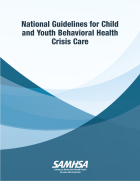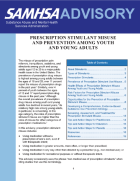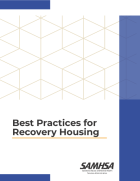This document updates SAMHSA’s 2018 document and outlines best practices for the implementation and operation of recovery housing. These best practices are intended to serve as a tool for states, governing bodies, providers, recovery house operators, and other interested stakeholders to improve the health of their citizens, reduce incidence of overdose, and promote recovery housing as a key support strategy in achieving and sustaining recovery.
Dashboard: Filter Bricks
Main page content

This document accompanies the Clinical Guidance for Treating Pregnant and Parenting Women with Opioid Use Disorder and Their Infants publication. It offers information about child welfare systems and what the health care provider's role is in developing a Plan of Safe Care.

The fourth supplemental resource to SAMHSA’s Clinical Guidance for Treating Pregnant and Parenting Women with Opioid Use Disorder and Their Infants publication. This document contains information for pregnant people with a substance use disorder and preparing to deliver.

The National Guidelines for Child and Youth Behavioral Health Crisis Care offers best practices, implementation strategies, and practical guidance for the design and development of services that meet the needs of children, youth, and their families experiencing a behavioral health crisis. Additional technical guidance is provided in a companion report produced by SAMHSA in conjunction with the National Association of State Mental Health Program Directors, A Safe Place to Be: Crisis Stabilization Services and Other Supports for Children and Youth.

There are protections in federal law, collectively known as “parity,” which are designed to ensure that certain types of health plans cover mental and substance use disorders no less generously than they cover other health issues. This resource can guide you to helpful materials and places.

This Advisory reviews the evidence on prescription stimulant misuse among youth and young adults. It establishes prescription stimulant misuse as a public health problem, identifies associated risk and protective factors, and provides programs and action steps for stakeholders to prevent misuse.

This Treatment Improvement Protocol (TIP) reviews the use of the three Food and Drug Administration (FDA)-approved medications used to treat OUD—methadone, naltrexone, and buprenorphine—and the other strategies and services needed to support recovery for people with OUD. This is a revision.

Alcohol remains the number one substance used by young people. These 24 legal policy summaries allow you to track how your state regulates underage drinking as compared to other states in order to help inform your prevention work.

This Advisory is based on TIP 55, Behavioral Health Services for People Who Are Homeless. It addresses the fundamentals of how providers and administrators can employ approaches to address the complex challenges of providing integrated treatment services to clients experiencing homelessness.

This Advisory is based on TIP 27, Comprehensive Case Management for Substance Abuse Treatment. It surveys the underlying principles and models of case management, discusses reasons substance use disorder (SUD) treatment providers might consider implementing or expanding the use of case management, and lists some case management-related resources and tools.
Displaying 1 - 10 out of 28


